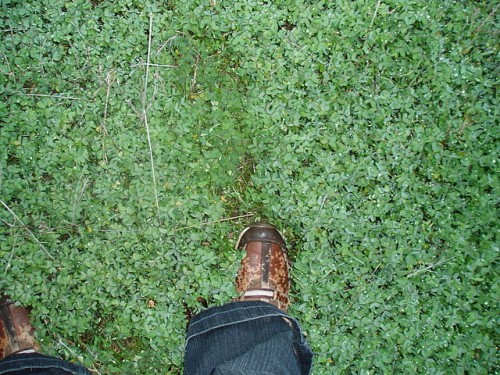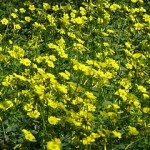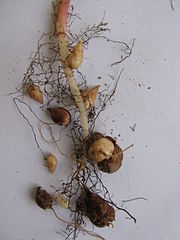 Oh, but I was proud of myself yesterday. The rain was coming, at last, at last, and I had an hour and a willing assistant and with these two things I removed nearly all of the oxalis flowers from my front yard. Without flowers, the seeds would not fall, the rain would not sow them, and our yard, for seasons to come, would have far fewer of these yellow flowers that seem to pop up like those whack-a-moles at pizza arcades.
Oh, but I was proud of myself yesterday. The rain was coming, at last, at last, and I had an hour and a willing assistant and with these two things I removed nearly all of the oxalis flowers from my front yard. Without flowers, the seeds would not fall, the rain would not sow them, and our yard, for seasons to come, would have far fewer of these yellow flowers that seem to pop up like those whack-a-moles at pizza arcades.
Only: no.
This is Oxalis pes-caprae, native to South Africa. In California, it has never been known to reproduce by seed; the root of the problem is, in fact, a bulb that lies dormant in summer and pushes out stems in fall and winter. Unless you get the bulb, you’ll get more bright-yellow flowers the next year. And because the bulbs are small, survive the compost, and travel well in soil that’s moved, the garden experts say you’re unlikely to ever get rid of it. (Some say chickens help.)
 Alas. The oxalis in the yard is actually quite pretty when it’s blooming. The neon yellow is a nice contrast to the “Pink Kaboom” succulents, the sunset-colored poppies. And there was a time when all I wanted was more of the stuff. Kids call it sourgrass. The oxalic acid in the plant has a pleasantly pungent taste. My friends and I would pick it along the chain-link fence at the edge of our playground, dangle the stems from our mouths, chew the green parts until they grew pulpy.
Alas. The oxalis in the yard is actually quite pretty when it’s blooming. The neon yellow is a nice contrast to the “Pink Kaboom” succulents, the sunset-colored poppies. And there was a time when all I wanted was more of the stuff. Kids call it sourgrass. The oxalic acid in the plant has a pleasantly pungent taste. My friends and I would pick it along the chain-link fence at the edge of our playground, dangle the stems from our mouths, chew the green parts until they grew pulpy.
Oxalic acid, though present in small quantities in a few stems, can be harmful or toxic in large quantities. It binds with calcium and forms calcium oxalate, a building block of kidney stones. There have been a few reports of grazers being poisoned after long-term feeding on oxalic acid-rich plants, including sourgrass. Perhaps I should be more concerned that all of my favorite foods have a high level of oxalic acid: dark beer, nuts, chocolate…
 The plant may be more wily than previously thought. O. pes-caprae in the Mediterranean basin—before known to only reproduce asexually—has been recently found to take a form that can play well with others of its kind, too.
The plant may be more wily than previously thought. O. pes-caprae in the Mediterranean basin—before known to only reproduce asexually—has been recently found to take a form that can play well with others of its kind, too.
So should I now look out at my yard and see all those lurking, nearly-chartreuse kidney stones, taunting me with tiny three-leaf clovers, both bulbs and gametes at the ready? Yet perhaps there is a greater future for them. Researchers looking for medicinal properties in weeds found that there’s a high level of antioxidants in oxalis. So perhaps instead you’ll find us no longer weeding, our yard bright yellow, our bodies fighting free radicals. Or maybe we’ll just be enjoying the spring, leaning against the tree trunks, stems with bright flowers falling from our mouths.
**
Images from Wikimedia Commons by Donama, MathKnight and Zachi Evenor, and Daniel Feliciano
My oxalis is pink and I’ve been digging it out for what feels like centuries now. I want to think I’m going to win but I seem to be aging faster than it does, so it might outlast me.
Once I understood that the weeds in my yard were actually wild flowers, I became a much happier person.
Pink oxalis seems like an important stop on the champagne tour, sounds beautiful.
Fred, I hope to be there someday with you, happy among the weeds–a philosophy that I should extend beyond my yard, too.
Cameron,
So glad you’re finding peace with oxalis. There are a few things I spend effort trying to get rid of, but wood sorrel is not one of them.
Have you read Noah’s Garden by Sara Stein? I think you’d like.